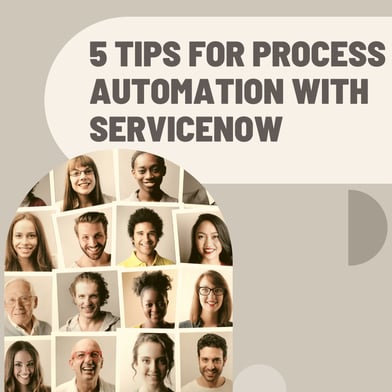5 Tips for Process Automation With ServiceNow
5 Tips for Process Automation With ServiceNow

ServiceNow is a go-to business process management solution for tens of thousands of companies worldwide—and for a good reason. It offers a flexible workflow platform that can be adjusted to suit a wide range of business needs. But with everything that ServiceNow can do, it can be a challenge to pinpoint the best ways to get the most out of this dynamic solution. Here are five tips for process automation with ServiceNow and streamlining your business. While the implementation of these tips will vary according to your business and the kinds of workflows you need to manage, using these suggestions can improve virtually any ServiceNow system.
1. Prioritize the End User in the Design Process
As you design workflow solutions with ServiceNow, the end-user should be the priority, primarily because work performance hinges on the quality of their experience. This can be a challenge if you already have an idea as to how ServiceNow can enhance workflow; deviating from your own strategy may take a shift in mindset.
To make this adjustment easier, you can:
- Meet with groups of end-users and ask them what will help them streamline their workflow.
- Roll out the ServiceNow solution in phases, telling users you want their feedback after each phase. This may also breed a sense of ownership in users.
- Don’t try to accomplish too many things at once. ServiceNow can help manage several different types of workflows, but trying to set up one management process for multiple kinds of tasks may add unnecessary complexity. It’s best to pinpoint specific groups of tasks for the benefit of users.
2. Optimize Your Dashboards for Simplicity and Efficiency
ServiceNow’s dashboard feature is one of its most powerful tools, particularly due to the preprogrammed widgets that can meet the needs of so many different kinds of businesses. However, because it’s so easy to drag and drop new features into your dashboard area, you could quickly complicate the user experience with superfluous or even distracting information. Before adding another feature to a dashboard, you should ask:
- Will this information help streamline the user’s workflow? Or is it only marginally helpful data?
- Will adding this widget detract from another one that provides more business-critical information?
For example, suppose you are using ServiceNow at an IT company to enhance the workflow of tech support reps. You already have widgets that track:
- The number of new tickets generated each day
- The number of tickets completed on a daily basis
- The average amount of time it takes to close a ticket
You’re considering adding a performance analytics widget to the dashboard. You may want to ask questions like:
- Will this widget add significant data or is it redundant?
- Would it be best to remove another widget to help unclutter the dashboard?
- How should this widget be sized in relation to the others?
3. Use Your KPIs as a Foundation
Using key performance indicators (KPIs) as the foundation for solutions you build with ServiceNow enhances the focus—and effectiveness—of your workflow strategy. In a sense, basing your use of ServiceNow on KPIs combines the best of both the top-down and bottom-up worlds.
With a top-down strategy, you start with the project and then break it down into phases. It’s guided by high-level principles and objectives. With a bottom-up approach, you focus on small tasks and then organize them into higher-level categories. However, by focusing on your performance indicators, you combine the high-level thinking of top-down tasking with the granular execution of bottom-up tasking.
For example, for a DevOps team, among the many KPIs you have, you may have one for the development process (speed of deployment) and one for the maintenance phase (customer satisfaction). When designing your ServiceNow solution, you can prioritize these by asking key questions such as:
- Which modules lend themselves to accurately and fairly measuring the speed of deployment?
- Which assortment of ServiceNow tools will provide the most comprehensive picture of customer satisfaction?
4. Audit Existing Automations to Uncover New Opportunities for ServiceNow Process Automation
Auditing the automations currently in place can reveal new ways to meet core objectives, particularly if the existing automations were designed long ago, perhaps when the organization was in a different phase of its growth cycle. During the audit process, it may be helpful to look for opportunities such as:
- Ways to use Flow Designer to reduce the number of clicks and manual inputs users have to perform
- New ways to integrate external systems that were developed after the automation you're auditing was deployed
- Ways for developers to combine and integrate different developers’ spokes, which are logical groupings of actions, subflows, and their dependencies
5. Outsource to a Trusted Service Provider
As your business grows, outsourcing your ServiceNow integration can save you time and valuable resources. ServiceNow provides you with a plethora of tools, but mastering each tool in the toolbox takes skill and experience in order to get the most out of process automation with ServiceNow. The best way to access the body of knowledge you need is to use an experienced, trusted ServiceNow partner, particularly one that has already deployed ServiceNow solutions in your field or one that’s closely related to it.
Maximize the Advantages of ServiceNow with GSI
By prioritizing the user, optimizing dashboards, using your KPIs, auditing existing automations, and outsourcing to a trusted partner, you can get the most out of ServiceNow’s suite of tools.
With ServiceNow managed services by GSI, you can take advantage of GSI's extensive experience providing ServiceNow solutions across a wide range of industries. Our team of experts can help you build new ServiceNow processes and automations or tweak existing solutions to ensure they support your objectives.
To learn more about how GSI can help you maximize your ServiceNow investment with ServiceNow Process Automation, reach out to us today.
Learn more about GSI
GSI, Inc. specializes in providing a broad spectrum of business, functional, and technical consulting services for ServiceNow, Oracle JD Edwards, Oracle NetSuite, Oracle Cloud, BMC, HubSpot, Salesforce, and other enterprise applications. We also offer an extensive array of cloud/hosting solutions for Oracle Cloud, Amazon Web Services (AWS), Microsoft Azure, Google Cloud, and private cloud.
GSI combines its deep application and industry experience with advanced A.I. and automation to deliver cutting-edge intelligence. This advanced intelligence combined with our outstanding people, allows GSI to deliver Service Excellence every single day.
GSI’s comprehensive suite of solutions includes AppCare, a 24/7 managed service; GatewayNow, an affordable, fully managed instance of ServiceNow ITSM; GENIUS AI, an Application Intelligence Platform (AIP) for creating application health and user experience monitors; GENISYS, a solution for modeling, measuring and maximizing system performance; gShield, a comprehensive security solution; RapidApproval®, a Salesforce AppExchange solution for streamlining the approval request process; RapidReconciler®, its inventory reconciliation software, and JDE Cloud9, a complete cloud-based hosted service. GSI consulting services are backed by its signature 100 percent guarantee. Founded in 2004, the rapidly growing company is headquartered in Atlanta with locations nationwide. GSI, Inc. has been named to Inc. Magazine’s Inc.5000 list of fastest-growing companies for two consecutive years.
Contact GSI to learn more about any of our ServiceNow consulting services offerings.

